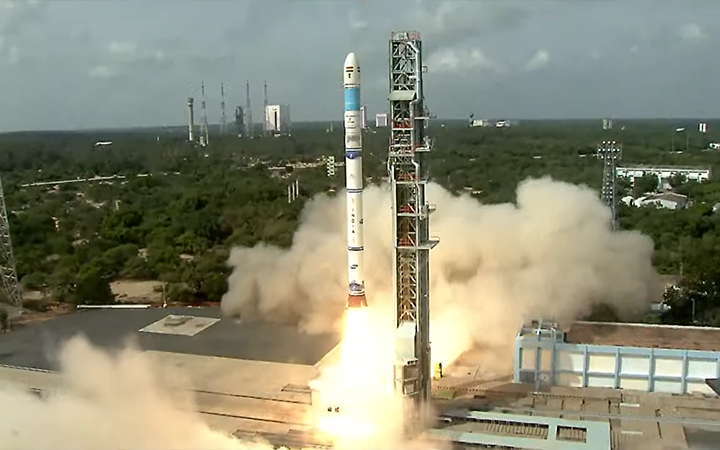Sriharikota, Andhra Pradesh – In a remarkable achievement for India’s space ambitions, the Indian Space Research Organisation (ISRO) successfully launched the EOS-08 satellite on Friday, marking the third and final development flight of the Small Satellite Launch Vehicle-03 (SSLV-D3). This mission, launched from the Satish Dhawan Space Centre in Sriharikota, not only completes the SSLV Development Project but also propels India’s microsatellite capabilities into a new era.
ISRO announced the successful mission on X (formerly Twitter), stating, “The third developmental flight of SSLV was successful. The SSLV-D3 placed EOS-08 precisely into the orbit. This marks the successful completion of ISRO/DOS’s SSLV Development Project. With technology transfer, the Indian industry and NSIL India will now produce SSLV for commercial missions.” This accomplishment signifies a major leap forward for ISRO and the Indian space industry, as it paves the way for future commercial satellite launches.
A Successful Countdown to Liftoff
The mission’s success came after a meticulously planned six-and-a-half-hour countdown, which began at 2:47 a.m. The spacecraft, designed for a one-year mission, was launched with three payloads aimed at advancing microsatellite technology, a key focus of the EOS-08 mission.
What Does the EOS-08 Success Mean for ISRO and India?
The successful launch of the EOS-08 satellite marks a significant milestone for ISRO, as it completes the SSLV Development Project. With this success, ISRO has effectively transferred SSLV technology to the Indian industry, enabling it to produce these launch vehicles for commercial missions. This transition is expected to boost the Indian space sector, positioning it as a competitive player in the global space market.
“This marks the successful completion of ISRO/DOS’s SSLV Development Project. With technology transfer, the Indian industry and NewSpace India Limited will now produce SSLV for commercial missions,” ISRO reiterated on X. This development underscores the growing capabilities of the Indian space industry and its readiness to handle commercial satellite launches, thus opening up new avenues for collaboration and growth.
Inside the EOS-08 Mission
The EOS-08 mission is a cornerstone in ISRO’s efforts to design and develop advanced microsatellites. Built on the Microsat/IMS-1 bus, the EOS-08 satellite carries three sophisticated payloads: the Electro-Optical Infrared Payload (EOIR), the Global Navigation Satellite System-Reflectometry Payload (GNSS-R), and the SiC UV Dosimeter. These payloads are designed to enhance ISRO’s capabilities in Earth observation, navigation, and radiation monitoring.
One of the primary goals of the EOS-08 mission was to develop a microsatellite equipped with payload instruments that are compatible with the microsatellite bus. Additionally, the mission aimed to incorporate new technologies that will be vital for future operational satellites. The SSLV-D3-EOS-08 mission has thus set a new benchmark for ISRO in the development of mainframe systems, particularly the Integrated Avionics system, which is crucial for the efficiency and reliability of future satellite missions.
Looking Ahead: ISRO’s Growing Impact
The successful launch of the SSLV-D3-EOS-08 is not just a technical achievement; it represents a broader vision of ISRO’s expanding influence in the global space industry. The SSLV is designed to carry satellites weighing up to 500 kg and place them into Low Earth Orbit (LEO), a capability that is in high demand for commercial and scientific missions worldwide.
As ISRO continues to develop and refine its satellite launch technologies, the organization is well-positioned to attract more commercial clients and partnerships. The successful completion of the SSLV Development Project is a testament to ISRO’s commitment to innovation and excellence, reinforcing India’s status as a rising power in space exploration.
The successful launch of the EOS-08 satellite marks a pivotal moment in India’s space journey, showcasing ISRO’s technological prowess and the readiness of the Indian industry to take on commercial satellite launches. As the SSLV technology is handed over to the private sector, we can expect to see a surge in commercial space missions from India, further establishing the country as a key player in the global space market.
For more insights into India’s space achievements and upcoming missions, follow us for the latest updates and in-depth analyses. Don’t miss out on the next big launch—stay informed and stay inspired!

